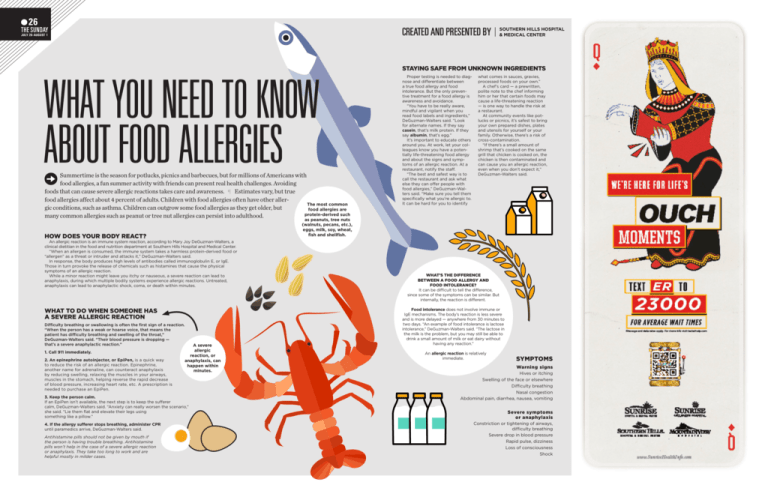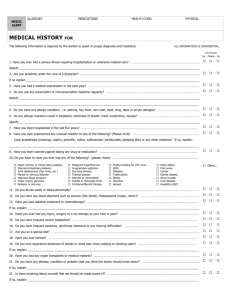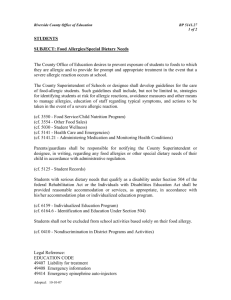View Full Infographic - Southern Hills Hospital & Medical Center
advertisement

26 CREATED AND PRESENTED BY THE SUNDAY JULY 26- AUGUST 1 WHAT YOU NEED TO KNOW ABOUT FOOD ALLERGIES Summertime is the season for potlucks, picnics and barbecues, but for millions of Americans with food allergies, a fun summer activity with friends can present real health challenges. Avoiding foods that can cause severe allergic reactions takes care and awareness. ¶ Estimates vary, but true food allergies affect about 4 percent of adults. Children with food allergies often have other allerThe most common gic conditions, such as asthma. Children can outgrow some food allergies as they get older, but food allergies are protein-derived such many common allergies such as peanut or tree nut allergies can persist into adulthood. An allergic reaction is an immune system reaction, according to Mary Joy DeGuzman-Walters, a clinical dietitian in the food and nutrition department at Southern Hills Hospital and Medical Center. “When an allergen is consumed, the immune system takes a harmless protein-derived food or “allergen” as a threat or intruder and attacks it,” DeGuzman-Walters said. In response, the body produces high levels of antibodies called immunoglobulin E, or IgE. Those in turn provoke the release of chemicals such as histamines that cause the physical symptoms of an allergic reaction. While a minor reaction might leave you itchy or nauseous, a severe reaction can lead to anaphylaxis, during which multiple bodily systems experience allergic reactions. Untreated, anaphylaxis can lead to anaphylactic shock, coma, or death within minutes. WHAT TO DO WHEN SOMEONE HAS A SEVERE ALLERGIC REACTION Difficulty breathing or swallowing is often the first sign of a reaction. “When the person has a weak or hoarse voice, that means the patient has difficulty breathing and swelling of the throat,” DeGuzman-Walters said. “Their blood pressure is dropping — ­ that’s a severe anaphylactic reaction.” 2. An epinephrine autoinjector, or EpiPen, is a quick way to reduce the risk of an allergic reaction. Epinephrine, another name for adrenaline, can counteract anaphylaxis by reducing swelling, relaxing the muscles in your airways, muscles in the stomach, helping reverse the rapid decrease of blood pressure, increasing heart rate, etc. A prescription is needed to purchase an EpiPen. A severe allergic reaction, or anaphylaxis, can happen within minutes. 3. Keep the person calm. If an EpiPen isn’t available, the next step is to keep the sufferer calm, DeGuzman-Walters said. “Anxiety can really worsen the scenario,” she said. “Lie them flat and elevate their legs using something like a pillow.” 4. If the allergy sufferer stops breathing, administer CPR until paramedics arrive, DeGuzman-Walters said. Antihistamine pills should not be given by mouth if the person is having trouble breathing. Antihistamine pills won’t help in the case of a severe allergic reaction or anaphylaxis. They take too long to work and are helpful mostly in milder cases. STAYING SAFE FROM UNKNOWN INGREDIENTS Proper testing is needed to diagnose and differentiate between a true food allergy and food intolerance. But the only preventive treatment for a food allergy is awareness and avoidance. “You have to be really aware, mindful and vigilant when you read food labels and ingredients,” DeGuzman-Walters said. “Look for alternate names. If they say casein, that’s milk protein. If they say albumin, that’s egg.” It’s important to educate others around you. At work, let your colleagues know you have a potentially life-threatening food allergy and about the signs and symptoms of an allergic reaction. At a restaurant, notify the staff. “The best and safest way is to call the restaurant and ask what else they can offer people with food allergies,” DeGuzman-Walters said. “Make sure you tell them specifically what you’re allergic to. It can be hard for you to identify what comes in sauces, gravies, processed foods on your own.” A chef’s card — a prewritten, polite note to the chef informing him or her that certain foods may cause a life-threatening reaction — is one way to handle the risk at a restaurant. At community events like potlucks or picnics, it’s safest to bring your own prepared dishes, plates and utensils for yourself or your family. Otherwise, there’s a risk of cross-contamination. “If there’s a small amount of shrimp that’s cooked on the same grill that chicken is cooked on, the chicken is then contaminated and can cause you an allergic reaction, even when you don’t expect it,” DeGuzman-Walters said. as peanuts, tree nuts (walnuts, pecans, etc.), eggs, milk, soy, wheat, fish and shellfish. HOW DOES YOUR BODY REACT? 1. Call 911 immediately. SOUTHERN HILLS HOSPITAL & MEDICAL CENTER WHAT’S THE DIFFERENCE BETWEEN A FOOD ALLERGY AND FOOD INTOLERANCE? It can be difficult to tell the difference, since some of the symptoms can be similar. But internally, the reaction is different. Food intolerance does not involve immune or IgE mechanisms. The body’s reaction is less severe and is more delayed — anywhere from 30 minutes to two days. “An example of food intolerance is lactose intolerance,” DeGuzman-Walters said. “The lactose in the milk is the problem, but you may still be able to drink a small amount of milk or eat dairy without having any reaction.” An allergic reaction is relatively immediate. SYMPTOMS Warning signs Hives or itching Swelling of the face or elsewhere Difficulty breathing Nasal congestion Abdominal pain, diarrhea, nausea, vomiting Severe symptoms or anaphylaxis Constriction or tightening of airways, difficulty breathing Severe drop in blood pressure Rapid pulse, dizziness Loss of consciousness Shock






